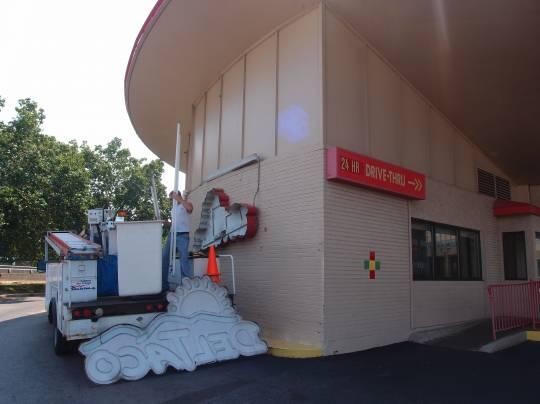Updated at 3:45 p.m. to include the perspective of Alderman Scott Ogilvie.
At a committee meeting last week, Alderman Scott Ogilvie pointed out Rick Yackey and his group of developers saved as much as $27 million in taxes by putting Council Plaza, the complex which houses the Saucer on South Grand formerly known as Del Taco, on the National Register of Historic Places. Ogilvie calculated this number based on Yackey's claim that he and his team spent $60 million renovating the complex, and the fact that federal and state historic tax credits would cover 45 percent of the total development expenditures.
However, Alderman Marlene Davis, in whose ward the building sits, notes that Yackey didn't save a penny in taxes for the Del Taco saucer. According to Davis, the historic tax breaks only apply to money spent developing property. And Yackey didn't touch the Saucer. The $60 million he spent all went to the other buildings in the plaza, so the historic tax credits applied only to those properties. (An official at the Missouri State Historic Preservation Office confirms that assertion to Daily RFT.)
"None of it would have gone to the Del Taco because it has not been renovated," Davis says. "When you're talking about tax credits from the state or the federal government that only deals with your renovation. He's received no benefit from the Del Taco building at all."
But it's not that simple.
The point that Yackey didn't get any direct tax credit for the Saucer is key because one argument against the building's demolition is based upon the idea that Yackey financially benefited from putting the Saucer on the historic register in 2007. By asking to demolish the building four years later, to some critics, Yackey seemed to be manipulating the historic preservation process: Claim the building is valuable when it saves you money, then say it's not actually that valuable when you want to save more money.
Of course, now Yackey is planning to renovate the building; Board Bill #118, to be voted on by the Board of Alderman this Friday, proposes to give him tax credits of a different sort, this time by declaring the place blighted.
In meetings, Yackey has stated that he didn't anticipate the Del Taco branch's failure, and he didn't anticipate that retailers wouldn't want the property, so he couldn't have planned to demolish it when he added it to the registry. (Yackey could not be reached for further comment.)
And, according to Davis, Yackey added the Saucer to the list not because he was trying to swindle the system, but rather because he had no choice. When you apply for a historic designation, she says, you have to include everything on a "footprint" of development, which is everything within the boundaries of a certain area. The Del Taco building wasn't necessarily added because Yackey thought it was particularly historic; it wasn't necessarily added because Yackey wanted to save some money; it was added, Davis says, because it was part of the parcel that included the actual historic buildings on site.
However, an official from the state preservation office, who requested that her name not be used because of the ongoing review of the issue, tells a slightly different story. According to the official, a developer is under no obligation to include every building in a complex. Which buildings you include in your application is totally up to you. Register staff can only make suggestions.
In fact, she says that officials with the historic register likely recommended that the Saucer be added to the application because it was part of the site's history.
Here's some background:
In January 2007, Yackey and a team of developers nominated a group of buildings on the corner of South Grand and Forest Park for the National Register of Historic Places. The application was accepted, for good reason. Back in the 1960s, the group of buildings, known as Council Plaza, provided subsidized housing for the elderly at a time when such a concept was unheard of. The complex was the largest publicly assisted housing project in Missouri and "one of only six percent in the country that offered on-site medical facilities to its tenants," according to the application. Governor George Romney would call it an "outstanding example of senior citizen housing."
Then, during the 1969 rent strike in St. Louis, tenants complained of poor housing conditions and the Teamsters Union took managerial control of the complex, which eventually led to the creation of the St. Louis Civil Alliance for Housing. The application concludes that "both civic and federal officials cast credit and praise to the programs and principles incorporated by Council Plaza and the Teamsters Union for installing new management and helping stabilize a dysfunctional public housing system in St. Louis."
Included in the Council Plaza application were two components: the buildings that used to be the housing complex and the adjacent building that "was constructed to serve as a garage and gas station for the tenants of Council Plaza."
That garage and gas station is the now famous flying saucer/former Phillips 66/former-Del Taco. And that's where the controversy began.
Yackey and his attorney have maintained that the building was added to the list due to historic events, not its architecture. That's true. However, the claim that architecture played no role in the application process is bogus. In the documents, the developers argue that the Saucer added to the character and integrity of the complex.
"Designed by prominent architects Schwartz and Van Hoefen, it makes a significant contribution to the midtown area through its mass, height, and fenestration. The original design is intact and it continues to maintain architectural integrity through its historical character, function, setting and design," the application states.
And the preservation office staffer agrees that the building's unique architecture undoubtedly played a role in the decision to add it to the registry.
So if Yackey didn't get tax credits from the Saucer, and doesn't think it is valuable enough to preserve, why would he add it to the registry in the first place?
Ogilvie thinks the Saucer was added to the Council Plaza nomination in order to strengthen its case for the registry.
"It's not clear that they would have gotten the historical designation if it weren't for all the the buildings," he says. "You have to trust that they chose the buildings that they thought gave them the best chance. The saucer building was used as an asset to get approval."
So while none of that $27 million was a direct result of the Saucer, it is possible that none of that $27 million would have existed if it wasn't for the Saucer, according to Ogilvie. In a sense, Yackey did financially benefit by putting the Saucer on the list.
Ogilvie says he plans to vote "no" on board Bill #118, not because he is necessarily against Yackey redeveloping the property, but because he doesn't think it would be right for Yackey to double dip in tax payer funds.
It will be up to the Cultural Resources Office and the Preservation Board to decide what comes next: to judge Yackey's intentions and assess the potential value of demolishing the building versus the potential value of keeping it.
The people may also get a say, since the public outcry might just draw enough interest from retailers to justify keeping the building up. Wanna help the cause? Tomorrow at 6 p.m., a group of preservationists led by STL-Style will hold a "Save Our Saucer" celebration in front of the former Del Taco at 212 South Grand.






